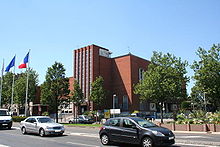
Le Bourget is a community of 16,500 people (2016) in the northeastern suburbs of Paris. It is 10.6 km (6.6 mi) from the center of Paris. It's perhaps most famous because of Le Bourget Airport, once Paris's principal airport, now used only for general aviation; however, only a very small part of the aerodrome lies is actually in Le Bourget.
Understand
[edit]The airport started commercial operations in 1919 and was Paris's only airport until the construction of Orly in 1932. Le Bourget, London's Croydon (now demolished) and Berlin's Tempelhof (now a municipal park) were "the trio of Classic European airports" whose design influenced all others that came later. On May 8, 1927, the White Bird took off from Le Bourget and its pilots, Charles Nungesser and François Coli, hoped to reach New York City without stopovers. Unfortunately the plane disappeared without a trace. It was finally Charles Lindbergh who made the first air crossing of the North Atlantic between New York and Paris on May 21, 1927. He was welcomed as the "victor" of the North Atlantic, posing on his Spirit of St. Louis. An enormous crowd also welcomed Edouard Daladier on September 29, 1938, after the signing of the Munich Agreement signed between Germany, France, the United Kingdom and Italy represented respectively by Adolf Hitler, Edouard Daladier, Neville Chamberlain and Benito Mussolini (who had acted as intermediary).
Get in
[edit]By train
[edit]- 1 Gare du Bourget (Bourget railway station). A Réseau Express Régional (RER) train station in Le Bourget. The station is in Zone 3 of the Carte orange. It is on the RER B suburban railway line.
- Tangentielle Nord (T11 Express). An express tramway that runs to Le Bourget from Épinay-sur-Seine in 15 min, a northern suburb of Paris.
Le Bourget is planned to one of the principal transportation hubs in the Paris North suburb: two train stations are planned in the long term as part of the Grand Paris Express project with the future lines 16 and 17.
By car
[edit]The town is served by two major highways (autoroutes): A1 autoroute in the north of the town, and A86 autoroute in the south of the city. Those two highways ensure a direct connection to major Paris Region hubs like La Defense (A86 West), Bobigny (A86 East), Roissy Charles de Gaulle Airport (A1 North), Paris (A1 South).
By plane
[edit]
- 2 Paris Le Bourget Airport (LBG IATA). A 24-hour airport dedicated to private jets and business aviation, as well as military and government flights. 11 km northeast of Paris, Le Bourget has been the busiest executive airport in Europe since 2007. As result, there are three runways to accommodate planes, and seven private terminals for fast and discrete travel. Companies like Air Charter Advisors and Priority Jet offer access to a variety of aircraft rentals based at Le Bourget and around the world, ranging from economical single and twin engine props, to luxury Gulfstreams and business jets.
Get around
[edit]See
[edit]- 1 Musée de l’air et de l’espace. Oct-Mar: Tu-Su 10:00-17:00; Apr-Sep: Tu-Su 10:00-18:00. Le Bourget is famous as the landing site for Charles Lindbergh's historic solo transatlantic crossing in 1927, and as the departure point two weeks earlier for the French biplane The White Bird (L'Oiseau Blanc), which took off in its own attempt at a trans-Atlantic flight but then mysteriously disappeared (the only known remaining piece — the jettisoned main landing gear — is kept here). Now, besides hosting the biannual Paris Air Show, it's France's main state-owned aviation museum. Its highlights include a Concorde prototype, and remnants of the unarmed P-38 flown by Antoine de Saint-Exupéry on his last mission, recovered from the Mediterranean Sea. Permanent exhibitions: free; activities for adults/under 26: €9/7 for 1 activity, €14/11 for 2, €17/13 for 3, €21/17 for 4.
- 2 Gagosian Gallery, 26 avenue de l’Europe, ☏ +33 1 48 16 16 47. Tu-Sa 11:00-18:00. A contemporary art gallery owned and directed by Larry Gagosian. Part of a group of galleries that exhibit some of the most influential artists of the 20th and 21st centuries.
- Gare du Bourget (Bourget railway station). Gare du Bourget was the primary point of deportation for French Jews during the Holocaust. Between 27 March 1942 and 23 June 1943, 42 trains carrying 40,450 Jews left Le Bourget for Auschwitz concentration camp and other extermination camps in Poland. Most had been imprisoned in the nearby Drancy internment camp. Drancy was organised, staffed and initially commanded by the civilian French police, who rounded up most of the victims. As Le Bourget station was too visible to the wider public, the next 21 trains left the Bobigny freight station.
Do
[edit]Buy
[edit]Eat
[edit]Drink
[edit]Sleep
[edit]- 1 Ibis Le Bourget, 104 Avenue Jean Mermoz, La Courneuve (2 km from Le Bourget airport and the Air Museum and 800 m from the RER station), ☏ +33 14 838 3333. Restaurant, terrace, bar, and free private parking. 4 disabled-accessible rooms. Pets welcome (€5). From €50.
- 2 Campanile Le Bourget Airport, 69 Avenue de l'Europe, ☏ +33 1 49 34 10 38. Restaurant, bar, gym, sauna, and free Wi-Fi. Reservations 08 92 23 48 12 (€0.35/min 08:00-22:00). From €57.
- 3 AC Hotel by Marriott Paris Le Bourget Airport, 2 Rue de la Haye, Dugny, ☏ +33 1 82 88 60 00.


